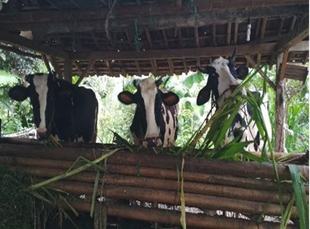White guava (Psidium guajava L.) fruit juice ameliorated the number of spermatogenic cells in rats (Rattus Novergicus) exposed to lead acetate

Downloads
This study aims to determine the effect of oral administration of white guava fruit juice (Psidium guajava L.) on the spermatogenic cells of rats (Rattus norvegicus) exposed orally to lead acetate. Twenty-five male rats (Rattus norvegicus) of the Wistar strain were randomly divided into five groups. Placebo group rats (P0) were given 0.5 mL distilled water twice every day orally at four-hour intervals. Groups T0, T1, T2, and T3 were given lead acetate 50 mg/kg bw orally, then respectively given distilled water, 100, 50 and 25% (v/v) white guava (Psidium guajava L.) fruit juice orally four hours later for 14 days. On day-15, the rats were sacrificed and their testicles were taken for histological preparations. Data were analyzed using Analysis of Variance followed by Duncan's Multiple Range Test. The results showed that the number of spermatogonia, spermatocytes and spermatids cells of rats in T0 group was lower (p <0.05) than in P0 group. Higher spermatogonia, spermatocytes and spermatids cells (p <0.05) were found in the T1 group compared to the T0 group. However, the number of spermatogonia and spermatocytes in the T1 group was still lower than in the P0 group. The number of spermatids in the T3 group was almost the same (p >0.05) as in the P0 group. This study found that white guava pure juice without dilution was the best for maintaining the number of spermatids, but was unable to restore the number of spermatogonia and spermatocyte cells in rats exposed to lead acetate.
Alifia AS, Wurlina W, Soeharsono S, Hernawati T, Sudjarwo SA, Utomo B, Mulyati S, Purnama MTE. 2023. Effect of white guava (Psidium guajava L.) fruit juice on the quality of lead acetate induced rats (Rattus norvegicus) spermatozoa. Ovozoa : J Anim Reprod. 12: 123-32.
Anggraini EJ, Wurlina W, Rahmahani J. 2021. Effect of Guava fruit (Psidium guajava L.) extract to the motility and viability spermatozoa of rats (Rattus novergicus) exposed to cigarette smoke. Poll Res. 40: 335-40.
Angulo-López JE, Flores-Gallegos AC, Torres-León C, Ramírez-Guzmán KN, Martínez GA, Aguilar CN. 2021. Guava (Psidium guajava L.) fruit and valorization of industrialization by-products. Processes 9: 1075.
Cannarella R, Condorelli RA, Mongioí¬ LM, La Vignera S, Calogero AE. 2020. Molecular biology of spermatogenesis: Novel targets of apparently idiopathic male infertility. Int J Mol Sci. 21: 1728.
Chaudhary P, Janmeda P, Docea AO, Yeskaliyeva B, Razis AFA, Modu B, Calina D, Sharifi-Rad J. 2023. Oxidative stress, free radicals and antioxidants: potential crosstalk in the pathophysiology of human diseases. Front Chem. 11: 1158198.
Collin SM, Venkatraman SK, Vijayakumar M, Kanimozhi V, Arbaaz SM, Stacey RGS, Anusha J, Choudhary R, Lvov V, Tovar GI, Senatov F, Koppala S, Swamiappan S. 2022. Bioaccumulation of lead (Pb) and its effects on human: A review. J Hazard Mater Adv. 7: 100094.
Debnath B, Singh WS, Manna K. 2019. Sources and toxicological effects of lead on human health. India J Med specialities 10: 66-71.
Dolati P, Zamiri MJ, Akhlaghi A, Khodabandeh Z, Mehrabani D, Atashi H, Jamhiri I. 2021. Reproductive and embryological toxicity of lead acetate in male mice and their offspring and mitigation effects of quercetin. J Trace Elem Med Biol. 67: 126793.
Dutta S, Sengupta P, Slama P, Roychoudhury S. 2021. Oxidative stress, testicular inflammatory pathways, and male reproduction. Int J Mol Sci. 22: 10043.
El-Magd MA, Kahilo KA, Nasr NE, Kamal T, Shukry M, Saleh AA. 2017. A potential mechanism associated with lead-induced testicular toxicity in rats. Andrologia 49: 9.
Grande G, Barrachina F, Soler-Ventura A, Jodar M, Mancini F, Marana R, Chiloiro S, Pontecorvi A, Oliva R, Milardi D. 2022. The role of testosterone in spermatogenesis: Lessons from proteome profiling of human spermatozoa in testosterone deficiency. Front Endocrinol. 13: 852661.
Halmo L, Nappe TM. 2023. Lead toxicity. In: StatPearls [Internet]. StatPearls Publishing. Treasure Island (FL), US. Updated 2023 Jul 4.
Haouas Z, Zidi I, Sallem A, Bhouri R, Ajina T, Zaouali M, Mehdi M. 2014. Reproductive toxicity of lead acetate in adult male rats: Histopathological and cytotoxic studies. J Cytol Histol. 6: 293.
Hartati R, Nadifan HI, Fidrianny I. 2020. Crystal Guava (Psidium guajava L.): Evaluation of in vitro antioxidant capacities and phytochemical content. Sci World J. 2020: 9413727.
Kumar A, Kumar A, M M S CP, Chaturvedi AK, Shabnam AA, Subrahmanyam G, Mondal R, Gupta DK, Malyan SK, S Kumar S, A Khan S, Yadav KK. 2020. Lead toxicity: Health hazards, influence on food chain, and sustainable remediation approaches. Int J Environ Res Public Health 17: 2179.
Machmudia A, Eliyani H, Widjiati W, Wurlina W. 2021. Effect of α-tocopherolon spermatogenic and Leydig cell counts of white rats (Rattus norvegicus) exposed to 2,3,7,8-Tetrachlorodibenzo-p-dioxin. Ovozoa : J Anim Reprod. 10: 72-80.
Massanyi P, Lukac N, Makarevich AV, Chrenek P, Forgacs Z, Zakrzewski M, Stawarz R, Toman R, Lazor P, Flesarova S. 2007. Lead-induced alterations in rat kidneys and testes in vivo. J Environ Sci Health A Tox Hazard Subst Environ Eng. 42: 671-6.
Naseer S, Hussain S, Naeem N, Pervaiz M, Rahman M. 2018. The phytochemistry and medicinal value of Psidium guajava (guava). Clin Phytosci. 4: 32.
Nicolli A, Mina GG, De Nuzzo D, Bortoletti I, Gambalunga A, Martinelli A, Pasqualato F, Cacciavillani M, Carrieri M, Trevisan A. 2020. Unusual domestic source of lead poisoning. Int J Environ Res Public Health 17: 4374.
Oduwole OO, Huhtaniemi IT, Misrahi M. 2021. The roles of Luteinizing Hormone, Follicle-Stimulating Hormone and Testosterone in spermatogenesis and folliculogenesis Revisited. Int J Mol Sci. 22: 12735.
Oduwole OO, Peltoketo H, Huhtaniemi IT. 2018. Role of Follicle-Stimulating Hormone in spermatogenesis. Front Endocrinol. 9: 763.
Offor SJ, Mbagwu HO, Orisakwe OE. 2019. Improvement of Lead Acetate-induced testicular injury and sperm quality deterioration by Solanum anomalum Thonn. ex. Schumach fruit extracts in albino rats. J Family Reprod Health. 13: 98-108.
Qamar AY, Naveed MI, Raza S, Fang X, Roy PK, Bang S, Tanga BM, Saadeldin IM, Lee S, Cho J. 2023. Role of antioxidants in fertility preservation of sperm - A narrative review. Anim Biosci. 36: 385-403.
Qi W, Qi W, Xiong D, Long M. 2022. Quercetin: Its antioxidant mechanism, antibacterial properties and potential application in prevention and control of toxipathy. Molecules 27: 6545.
Santi D, Crépieux P, Reiter E, Spaggiari G, Brigante G, Casarini L, Rochira V, Simoni M. 2020. Follicle-stimulating Hormone (FSH) action on spermatogenesis: A focus on physiological and therapeutic roles. J Clin Med. 9:1014.
Santos-Sánchez NF, Salas-Coronado R, Villanueva-Cañongo C, Hernández-Carlos B. 2019. Antioxidant compounds and their antioxidant mechanism. In: Shalaby E (Ed). Antioxidants. IntechOpen Limited.
Septiani RA, Hamid IS, Sabdoningrum EK, Ma'ruf A, Hestianah EP, Mafruchati M. 2022. Tomato (Lycopersicon esculentum Mill.) juice restored the number of Leydig cells, and the diameter of the seminiferous tubules of mice (Mus musculus) exposed to lead acetate. Ovozoa : J Anim Reprod. 11: 123-9.
Sharifi-Rad M, Kumar NVA, Zucca P, Varoni EM, Dini L, Panzarini E, Rajkovic J, Fokou PVT, Azzini E, Peluso I, Mishra AP, Nigam M, El Rayess Y, El Beyrouthy M, Polito L, Iriti M, Martins N, Martorell M, Docea AO, Setzer WN, Calina D, Cho WC, Sharifi-Rad J. 2020. Lifestyle, oxidative stress, and antioxidants: Back and forth in the pathophysiology of chronic diseases. Front Physiol. 11: 694.
Smith LB, Walker WH. 2014. The regulation of spermatogenesis by androgens. Semin Cell Dev Biol. 30: 2-13.
Su LJ, Zhang JH, Gomez H, Murugan R, Hong X, Xu D, Jiang F, Peng ZY. Reactive Oxygen Species-induced lipid peroxidation in apoptosis, autophagy, and ferroptosis. Oxid Med Cell Longev. 2019: 5080843.
Wang JM, Li ZF, Yang WX, Tan FQ. 2022. Follicle-stimulating hormone signaling in Sertoli cells: A licence to the early stages of spermatogenesis. Reprod Biol Endocrinol. 20: 97.
WHO (World Health Organization). 2023. Lead poisoning. Up dated 11 August 2023. 23 September 2023.
Xu D, Hu MJ, Wang YQ, Cui YL. 2019. Antioxidant activities of Quercetin and its complexes for medicinal application. Molecules 24: 1123.
Copyright (c) 2024 Muhammad Faizal Adiutomo, Suzanita Utama, Herry Agoes Hermadi, Wurlina Wurlina, Hardany Primarizky, Rochmah Kurnijasanti

This work is licensed under a Creative Commons Attribution-ShareAlike 4.0 International License.
Ovozoa by Unair is licensed under a Creative Commons Attribution-ShareAlike 4.0 International License.
1. The journal allows the author to hold the copyright of the article without restrictions.
2. The journal allows the author(s) to retain publishing rights without restrictions
3. The legal formal aspect of journal publication accessibility refers to Creative Commons Attribution Share-Alike (CC BY-SA).
4. The Creative Commons Attribution Share-Alike (CC BY-SA) license allows re-distribution and re-use of a licensed work on the conditions that the creator is appropriately credited and that any derivative work is made available under "the same, similar or a compatible license”. Other than the conditions mentioned above, the editorial board is not responsible for copyright violation.




































